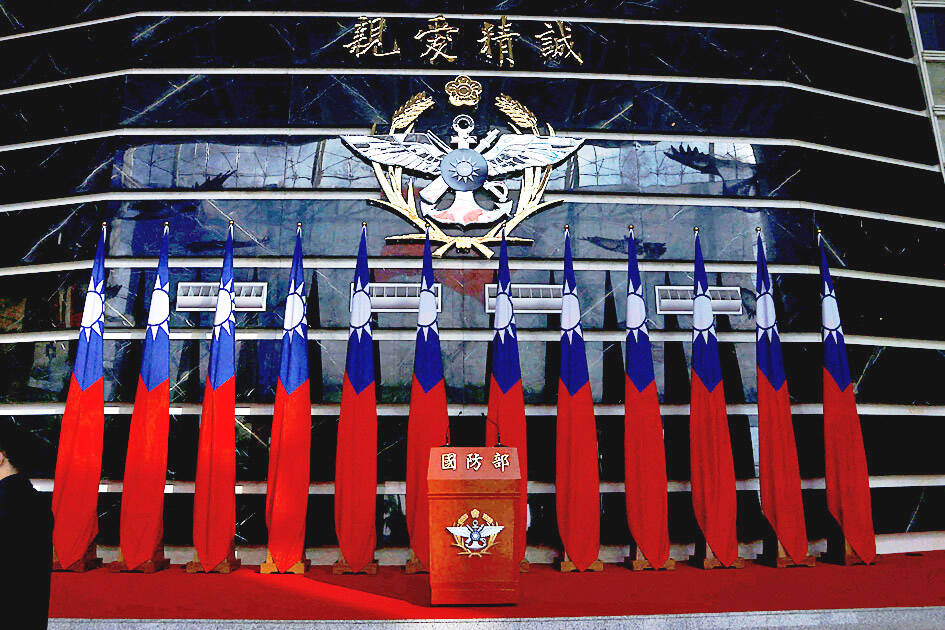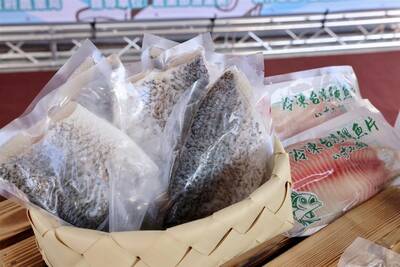A mobile air defense system manufactured by Taiwan’s weapons developer is to make its debut on Tuesday during a live-fire exercise in Pingtung County, a source in the nation’s military with knowledge on the matter said.
The drill, slated for Tuesday at the Jiupeng (九鵬) military base in Manjhou Township (滿州) operated by state-owned weapons developer the Chungshan Institute of Science and Technology, is to test an assortment of missile systems, including a missile known as the “field air defense weapons system.”
The system is a car-mounted variant of the Tien Chien II (TC-2) air-to-air missile, the source said, adding that a total of three missiles of the TC-2 variant would be launched during the drill.

Photo: Ann Wang, Reuters
Developed by Chungshan Institute, it is a surface-launched version of the TC-2 model that is controlled by a command post vehicle and consists of a launch platform, a car-mounted array radar system and a missile vehicle, they said.
It was delivered to the Republic of China Army in May last year and replaced the outgoing MIM-72A/M48 Chaparral surface-to-air missiles, the source said.
The TC-2 variant has a 15km range and can be deployed against rotary-wing and fixed-wing aircraft, drones and cruise missiles, the source added.
The Chungshan Institute plans to test the field air defense weapons system once a year in live-fire exercises, they said.
Other missiles in Taiwan’s arsenal to join the drill include AGM-114 Hellfire, Thunderbolt-2000 multiple launch rocket system and FIM-92 Stinger missiles, the source said.
The surface-launched TC-2 missiles could beef up mid-range air defense capability and offer more cover for ground troops by countering air raids, Chou Yu-ping (周宇平), a retired air force officer, said.
The surface-launched TC-2 could be used in combination with shorter-range Stinger missiles to cover more bases as part of Taiwan’s low to mid-altitude air defense, while the domestically developed Tien Kung family of air defense missiles and the MIM-104 Patriot missiles could be deployed against high and ultra-high altitude targets, Institute for National Defense and Security Research associate researcher Shu Hsiao-huang (舒孝煌) said.

Taiwan's Vice President Hsiao Bi-khim (蕭美琴) said Saturday that she would not be intimidated by the Chinese Communist Party (CCP), following reports that Chinese agents planned to ram her car during a visit to the Czech Republic last year. "I had a great visit to Prague & thank the Czech authorities for their hospitality & ensuring my safety," Hsiao said on social media platform X. "The CCP's unlawful activities will NOT intimidate me from voicing Taiwan's interests in the international community," she wrote. Hsiao visited the Czech Republic on March 18 last year as vice president-elect and met with Czech Senate leadership, including

There have been clear signs of Chinese Communist Party (CCP) attempts to interfere in the nationwide recall vote on July 26 in support of Chinese Nationalist Party (KMT) legislators facing recall, an unnamed government official said, warning about possible further actions. The CCP is actively involved in Taiwanese politics, and interference in the recall vote is to be expected, with multiple Chinese state media and TAO attempts to discredit the Democratic Progressive Party (DPP) and undermine public support of their recall movement, the official said. This interference includes a smear campaign initiated this month by a pro-Beijing Hong Kong news outlet against

A week-long exhibition on modern Tibetan history and the Dalai Lama’s global advocacy opened yesterday in Taipei, featuring quotes and artworks highlighting human rights and China’s ongoing repression of Tibetans, Hong Kongers and Uighurs. The exhibition, the first organized by the Human Rights Network for Tibet and Taiwan (HRNTT), is titled “From the Snowy Ridges to the Ocean of Wisdom.” “It would be impossible for Tibetans inside Tibet to hold an exhibition like this — we can do it. because we live in a free and democratic country,” HRNTT secretary-general Tashi Tsering said. Tashi Tsering, a Taiwan-based Tibetan who has never

A first shipment of five tons of Taiwan tilapia was sent from Tainan to Singapore on Wednesday, following an order valued at NT$600,000 (US$20,500) placed with a company in the city. The products, including frozen whole fish and pre- cooked fish belly, were dispatched from Jiangjun Fishing Harbor, where a new aquatic processing and logistics center is under construction. At the launch, Tainan Mayor Huang Wei-che (黃偉哲) called the move a “breakthrough,” marking Taiwan’s expansion into the Singaporean tilapia market. Taiwan’s tilapia exports have traditionally focused on the United States, Canada, and the Middle East, Huang said, adding that the new foothold in